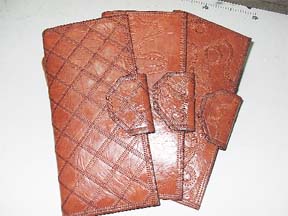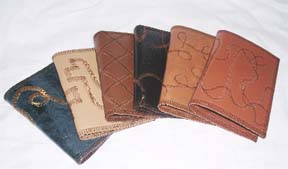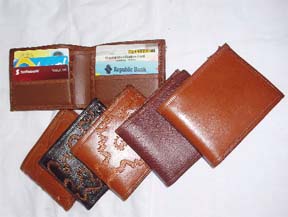Lexton Williams is an articulate 20 year-old with a passionate belief in his talent as a creative artist and a conviction that what he has to offer can become a lucrative business. He appears, seemingly out of a sense of what one might call the optimism of inexperience, more than a trifle unphased by the competitive nature of the local arts and craft industry. His work, he says, “speaks for itself.” His medium is synthetic leather, the texture of which, he says, allows him far more generous self-expression in the items that he produces – wallets, bags, passport cases and a host of other items which he says are on sale at department stores and some supermarkets in the city.

It is the typical small business, one that produces small quantities to order, lacks both the money and the material for mass production and is driven by myriad plans some of which are only partially developed. Lexton’s talent and his enterprise have caught the attention of the Guyana Youth Business Trust (GYBT) which has provided a measure of both financial and technical support for his venture. Still, he concedes that after four years, he is yet to convert his budding enterprise into a structured business. There are, he says, “problems of finance.” It is the same story that you hear from the “army” of small and micro businesses that have mushroomed in Guyana in response to what has long been a permanent condition of high unemployment; a story of ideas, enterprise and talent that are suppressed by an absence of finance and a commercial banking sector that invariably insists on conditionalities which these people like Lexton simply cannot meet.


That is why when you ask Lexton about overseas markets he says with a refreshing candour that he “cannot go there yet.” What he is seeking to do first is “to saturate Guyana” before he goes “international.” Even that still seems some distance away. Things, he says, are beginning to look up. Having operated from a limited space in Kitty he has now moved to Grove on the East Bank where, he says, he is more comfortable.

Still, plans to go forward continue to be constrained by circumstances of limited capital and Lexton’s efforts to “accumulate finance” – as he puts it, coincide with a period of reduced spending on what are considered non essential items. Still, he is hopeful that the collective persistence of the local arts and craft industry can create a shift from what appears to be a proclivity for cheaper, mass-produced Chinese imports. A member of the Guyana Arts Association, Lexton applauds the opportunities afforded craft producers to market their products overseas. Up until now he has been unable to afford to attend a major international trade fair. His marketing strategy is driven by what bears a conspicuous resemblance to a sort of “flat foot hustle,” a constant unrelenting regimen of business places across the country in an effort to brand his products. Lexton says that apart from visiting Berbice and the West Coast he has been seeking to “saturate Georgetown.” With no real marketing budget, however, saturating Georgetown is still some distance away. What cannot be denied is Lexton’s evident talent and his unbridled optimism. He is, however, a dufficiently level-headed young man to recognize that it will take more than a positive outlook to take him to the top. While he appreciates the role that the GYBT has played in what he has been able to accomplish up until now, you sense in Lexton a sense of disappointment over the fact that support for fledgeling small businesses in Guyana is still seriously deficient. Happily for him he appears to be under no illusions as to the arguous nature of where he wants to go.
